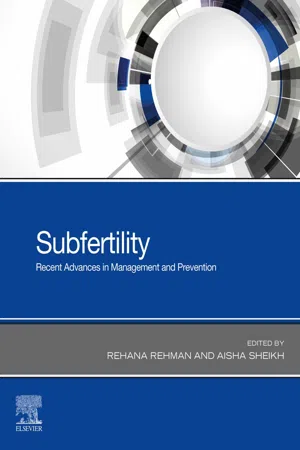
Subfertility
Recent Advances in Management and Prevention
- 232 pages
- English
- ePUB (mobile friendly)
- Available on iOS & Android
Subfertility
Recent Advances in Management and Prevention
About this book
With the increased prevalence of subfertility (any form of reduced fertility with prolonged time of unwanted non-conception) and the number of subfertile patients turning to assisted reproductive clinics for help, Subfertility: Recent Advances for Management and Prevention is a much-needed resource for today's health care providers. Written by doctors with extensive expertise in the areas of reproductive physiology and endocrinology, it provides a description of the methods for achieving conception, an overview of the causes of subfertility and how to detect them, a review of the psychological impact of subfertility, guidelines for the treatment of subfertility, and a look at assisted reproductive technologies.- rovides a holistic approach to the causes and treatment of subfertility, with guidance on selecting patients on the basis of ovarian reserve/sperm parameters and the management of special endocrine abnormalities like polycystic ovarian syndrome, endometriosis, and thyroid disorders.- Offers a concise review of the most recent advances for improving assisted reproductive techniques.- Covers reproductive physiology and the causes of subfertility, with special focus on endocrine abnormalities that lead to subfertility.- Consolidates today's available information on this timely topic into a single, convenient resource.
Frequently asked questions
- Essential is ideal for learners and professionals who enjoy exploring a wide range of subjects. Access the Essential Library with 800,000+ trusted titles and best-sellers across business, personal growth, and the humanities. Includes unlimited reading time and Standard Read Aloud voice.
- Complete: Perfect for advanced learners and researchers needing full, unrestricted access. Unlock 1.4M+ books across hundreds of subjects, including academic and specialized titles. The Complete Plan also includes advanced features like Premium Read Aloud and Research Assistant.
Please note we cannot support devices running on iOS 13 and Android 7 or earlier. Learn more about using the app.
Information
Chapter 1: Anatomy and embryology of male and female reproductive systems
Abstract
Keywords
Embryology of the male and female reproductive systems

| Gene name or pseudonyms | Human gene locus | Protein name | Protein type | Genetic or cellular targets of factors | Action of factors | Effects of overexpression or underexpression of gene |
|---|---|---|---|---|---|---|
| Factors involved in both ovary and testis sex determinations | ||||||
| SF1* NR5A1 FTZF1 Ad4BP | 9q33 | SF1 | Orphan nuclear receptor/zinc finger transcription factor | WT1, SRY, SOX9, DAX1, GNRHR, LHβ, ACTHR, AMH, AMHR, STAR, CYP11A1, CYP21A2, CYP11B1, OXT, and others | Activates transcription of many genes in the development of gonads, adrenal glands; regulates steroidogenesis; synergizes with WT1; antagonizes; DAXi. Dose-dependent activity. | KO mice (XX and XY): no gonads or adrenals; retained Müllerian structures; abnormal hypothalamus. Haploinsufficient mice: reduced but not absent adrenal function Homozygous human mutation: 46,XY sex reversal and adrenal hypoplasia Heterozygous human mutation: 46,XX normal ovary, partial adrenal insufficiency |
| WT1* | 11p13 | WT1 | Zinc finger transcription factor; tumor repressor | DAX1, AMH, SRY, IGF2I, IGF1R, PDGFA, PAX2 | Represses transcription; activates transcription of SRY; dose-dependent effects | XY homozygous deletion of WT1 + KTS isoform: male-to-female sex reversal; XY homozygous deletion of WT1 + KTS isoform: streak gonads in XX and XY. Human Denys–Drash syndrome: gonadal dysgenesis, congenital nephropathy, Wilms’ tumor |
| GATA4* | 8p23.1-p22 | GATA4 | Zinc finger transcription factor | “GATA” DNA motif; AMH; genes encoding steroidogenic enzymes | Expressed early in both ovary and testis; interacts with FOG2 | KO mice: embryonic lethal, no gonadal phenotype reported. Most human mutations cause isolated cardiac defects. Rare cases are reported with both cardiac defects and 46,XY gonadal dysgenesis |
| CBX2* | 17q25.3 | CBX2 | Transcription repressor | Possibly ... | ||
Table of contents
- Cover image
- Title page
- Table of Contents
- Copyright
- About the editors
- Author biographies
- Chapter 1: Anatomy and embryology of male and female reproductive systems
- Chapter 2: Reproductive endocrine physiology
- Chapter 3: Reproductive cycle
- Chapter 4: Ovarian reserve
- Chapter 5: Introduction to subfertility
- Chapter 6: Impact of subfertility
- Chapter 7: Polycystic ovary syndrome and subfertility
- Chapter 8: Endometriosis and subfertility
- Chapter 9: Thyroid imbalance and subfertility
- Chapter 10: Pituitary disorders and subfertility
- Chapter 11: Oxidative stress and oocyte microenvironment
- Chapter 12: Assisted reproductive techniques
- Chapter 13: Way forward
- Index